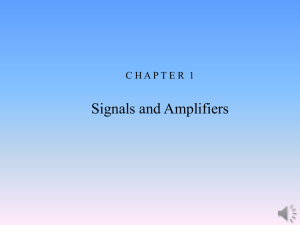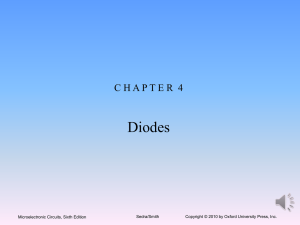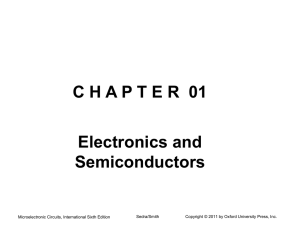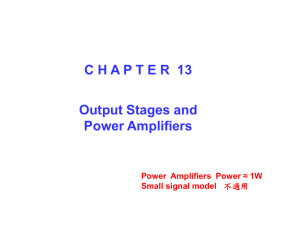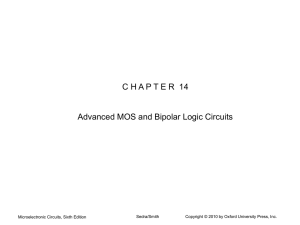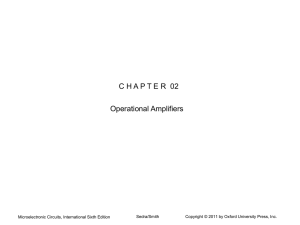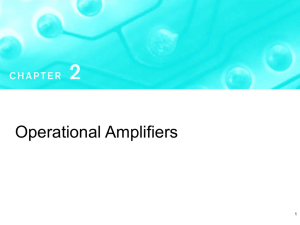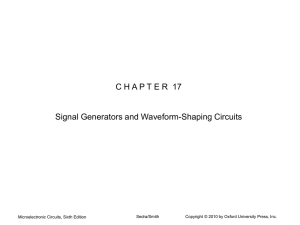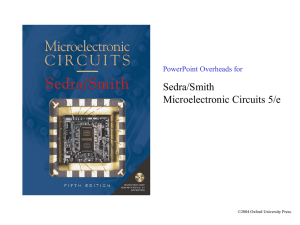Slide 1 - Oxford University Press
advertisement
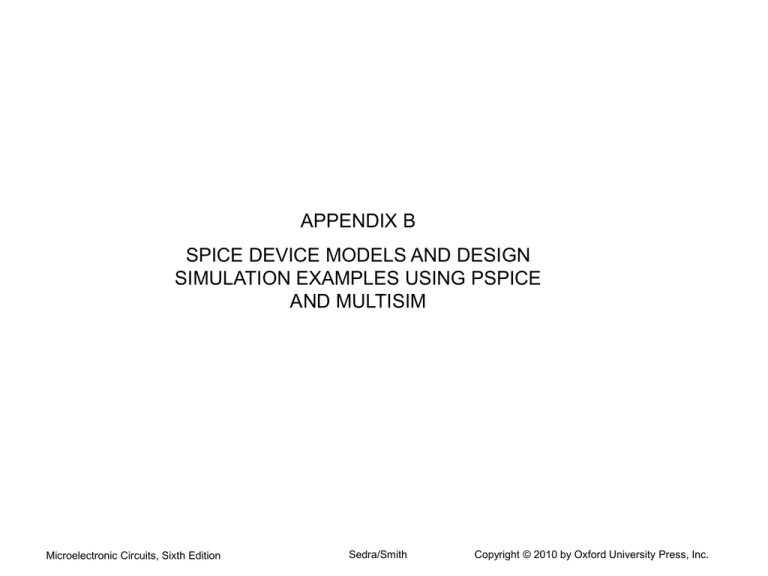
APPENDIX B SPICE DEVICE MODELS AND DESIGN SIMULATION EXAMPLES USING PSPICE AND MULTISIM Microelectronic Circuits, Sixth Edition Sedra/Smith Copyright © 2010 by Oxford University Press, Inc. Figure B.1 A linear macromodel used to model the finite gain and bandwidth of an internally compensated op amp. Microelectronic Circuits, Sixth Edition Sedra/Smith Copyright © 2010 by Oxford University Press, Inc. Figure B.2 A comprehensive linear macromodel of an internally compensated op amp. Microelectronic Circuits, Sixth Edition Sedra/Smith Copyright © 2010 by Oxford University Press, Inc. Figure B.3 The SPICE diode model. Microelectronic Circuits, Sixth Edition Sedra/Smith Copyright © 2010 by Oxford University Press, Inc. Figure B.4 Equivalent-circuit model used to simulate the zener diode in SPICE. Diode D1 is ideal and can be approximated in SPICE by using a very small value for n (say n = 0.01). Microelectronic Circuits, Sixth Edition Sedra/Smith Copyright © 2010 by Oxford University Press, Inc. Figure B.5 The transport form of the Ebers-Moll model for an npn BJT. Microelectronic Circuits, Sixth Edition Sedra/Smith Copyright © 2010 by Oxford University Press, Inc. Figure B.6 The SPICE large-signal model for an npn BJT Microelectronic Circuits, Sixth Edition Sedra/Smith Copyright © 2010 by Oxford University Press, Inc. Figure B.7 Frequency response of the closed-loop amplifier in Example PS.2.1. Microelectronic Circuits, Sixth Edition Sedra/Smith Copyright © 2010 by Oxford University Press, Inc. Figure B.8 Step response of the closed-loop amplifier in Example PS.2.1. Microelectronic Circuits, Sixth Edition Sedra/Smith Copyright © 2010 by Oxford University Press, Inc. Microelectronic Circuits, Sixth Edition Sedra/Smith Copyright © 2010 by Oxford University Press, Inc. Microelectronic Circuits, Sixth Edition Sedra/Smith Copyright © 2010 by Oxford University Press, Inc. Microelectronic Circuits, Sixth Edition Sedra/Smith Copyright © 2010 by Oxford University Press, Inc. Microelectronic Circuits, Sixth Edition Sedra/Smith Copyright © 2010 by Oxford University Press, Inc. Figure B.13 Schematic capture of the 5-V dc power supply in Example PS.4.1. Microelectronic Circuits, Sixth Edition Sedra/Smith Copyright © 2010 by Oxford University Press, Inc. Microelectronic Circuits, Sixth Edition Sedra/Smith Copyright © 2010 by Oxford University Press, Inc. Microelectronic Circuits, Sixth Edition Sedra/Smith Copyright © 2010 by Oxford University Press, Inc. Figure B.16 (a) Schematic capture of the voltage-doubler circuit in Exercise B.1. (b) Various voltage waveforms in the voltage-doubler circuit. The top graph displays the input sine-wave voltage signal, the middle graph displays the voltage across diode D1, and the bottom graph displays the voltage that appears at the output. Microelectronic Circuits, Sixth Edition Sedra/Smith Copyright © 2010 by Oxford University Press, Inc. Figure B.16 continued Microelectronic Circuits, Sixth Edition Sedra/Smith Copyright © 2010 by Oxford University Press, Inc. Figure B.17 Schematic capture of the CS amplifier in Example PS.5.1. Microelectronic Circuits, Sixth Edition Sedra/Smith Copyright © 2010 by Oxford University Press, Inc. Microelectronic Circuits, Sixth Edition Sedra/Smith Copyright © 2010 by Oxford University Press, Inc. Microelectronic Circuits, Sixth Edition Sedra/Smith Copyright © 2010 by Oxford University Press, Inc. Microelectronic Circuits, Sixth Edition Sedra/Smith Copyright © 2010 by Oxford University Press, Inc. Figure B.21 Schematic capture of the CE amplifier in Example PS.6.2. Microelectronic Circuits, Sixth Edition Sedra/Smith Copyright © 2010 by Oxford University Press, Inc. Microelectronic Circuits, Sixth Edition Sedra/Smith Copyright © 2010 by Oxford University Press, Inc. Figure B.23 Schematic capture of the CS amplifier in Example PS.7.1. Microelectronic Circuits, Sixth Edition Sedra/Smith Copyright © 2010 by Oxford University Press, Inc. Figure B.24 Transistor equivalency. Microelectronic Circuits, Sixth Edition Sedra/Smith Copyright © 2010 by Oxford University Press, Inc. Microelectronic Circuits, Sixth Edition Sedra/Smith Copyright © 2010 by Oxford University Press, Inc. Figure B.26 Schematic capture of the op-amp circuit in Example 7.6. Microelectronic Circuits, Sixth Edition Sedra/Smith Copyright © 2010 by Oxford University Press, Inc. Figure B.27 (a) The large-signal differential transfer characteristic of the op-amp circuit in Fig. B.26. The commonmode input voltage VCM is set to 0 V. (b) An expanded view of the transfer characteristic in the high-gain region. Microelectronic Circuits, Sixth Edition Sedra/Smith Copyright © 2010 by Oxford University Press, Inc. Figure B.28 Frequency response of (a) the op-amp circuit in Fig. B.26 and (b) the op-amp circuit in Fig. B.26 but with a resistor R′3 = R 3 inserted in the collector of Q4 to make the op-amp circuit symmetrical. Microelectronic Circuits, Sixth Edition Sedra/Smith Copyright © 2010 by Oxford University Press, Inc. Microelectronic Circuits, Sixth Edition Sedra/Smith Copyright © 2010 by Oxford University Press, Inc. Figure B.30 Schematic capture of the CS amplifier in Example PS.9.1 Microelectronic Circuits, Sixth Edition Sedra/Smith Copyright © 2010 by Oxford University Press, Inc. Microelectronic Circuits, Sixth Edition Sedra/Smith Copyright © 2010 by Oxford University Press, Inc. Figure B.32 Schematic capture of the of folded cascode amplifier in Example PS.9.1. Microelectronic Circuits, Sixth Edition Sedra/Smith Copyright © 2010 by Oxford University Press, Inc. Figure B.33 Circuit of the shunt–series feedback amplifier in Example PS.10.1. Microelectronic Circuits, Sixth Edition Sedra/Smith Copyright © 2010 by Oxford University Press, Inc. Figure B.34 Circuits for simulating (a) the open-circuit voltage transfer function Toc and (b) the short-circuit current transfer function Tsc of the feedback amplifier in Fig. B.33 for the purpose of computing its loop gain. Microelectronic Circuits, Sixth Edition Sedra/Smith Copyright © 2010 by Oxford University Press, Inc. Figure B.35 Circuit for simulating the loop gain of the feedback amplifier circuit in Fig. B.33 using the replica-circuit method. Microelectronic Circuits, Sixth Edition Sedra/Smith Copyright © 2010 by Oxford University Press, Inc. Microelectronic Circuits, Sixth Edition Sedra/Smith Copyright © 2010 by Oxford University Press, Inc. Figure B.37 Capture schematic of the class B output stage in Example PS.11.1. Microelectronic Circuits, Sixth Edition Sedra/Smith Copyright © 2010 by Oxford University Press, Inc. Figure B.38 Several waveforms associated with the class B output stage (shown in Fig. B.37) when excited by a 17.9-V, 1-kHz sinusoidal signal. The upper graph displays the voltage across the load resistance, the middle graph displays the load current, and the lower graph displays the instantaneous and average power dissipated by the load. Microelectronic Circuits, Sixth Edition Sedra/Smith Copyright © 2010 by Oxford University Press, Inc. Figure B.39 The voltage (upper graph), current (middle graph), and instantaneous and average power (bottom graph) supplied by the positive voltage supply (+VCC) in the circuit of Fig. B.37. Microelectronic Circuits, Sixth Edition Sedra/Smith Copyright © 2010 by Oxford University Press, Inc. Figure B.40 Waveforms of the voltage across, the current through, and the power dissipated in the pnp transistor QP of the output stage shown in Fig. B.37. Microelectronic Circuits, Sixth Edition Sedra/Smith Copyright © 2010 by Oxford University Press, Inc. Figure B.41 Transfer characteristic of the class B output stage of Fig. B.37. Microelectronic Circuits, Sixth Edition Sedra/Smith Copyright © 2010 by Oxford University Press, Inc. Figure B.42 Fourier-series components of the output waveform of the class B output stage in Fig. B.37. Microelectronic Circuits, Sixth Edition Sedra/Smith Copyright © 2010 by Oxford University Press, Inc. Figure B.43 Schematic capture of the two-stage CMOS op amp in Example PS.12.1 Microelectronic Circuits, Sixth Edition Sedra/Smith Copyright © 2010 by Oxford University Press, Inc. Microelectronic Circuits, Sixth Edition Sedra/Smith Copyright © 2010 by Oxford University Press, Inc. Microelectronic Circuits, Sixth Edition Sedra/Smith Copyright © 2010 by Oxford University Press, Inc. Microelectronic Circuits, Sixth Edition Sedra/Smith Copyright © 2010 by Oxford University Press, Inc. Figure B.47 Small-signal step response (for a 10-mV step input) of the op-amp circuit in Fig. B.43 connected in a unitygain configuration: PM = 55° (CC = 0.6 pF, R = 1.53 kV) and PM = 75 (CC = 0.6 pF, R = 3.2 kV). Microelectronic Circuits, Sixth Edition Sedra/Smith Copyright © 2010 by Oxford University Press, Inc. Figure B.48 Large-signal step response (for a 3.3-V step-input) of the op-amp circuit in Fig. B.43 connected in a unity-gain configuration. The slope of the rising and falling edges of the output waveform correspond to the slew rate of the op amp. Microelectronic Circuits, Sixth Edition Sedra/Smith Copyright © 2010 by Oxford University Press, Inc. Figure B.49 Schematic capture of the CMOS inverter in Example PS.13.1. Microelectronic Circuits, Sixth Edition Sedra/Smith Copyright © 2010 by Oxford University Press, Inc.
